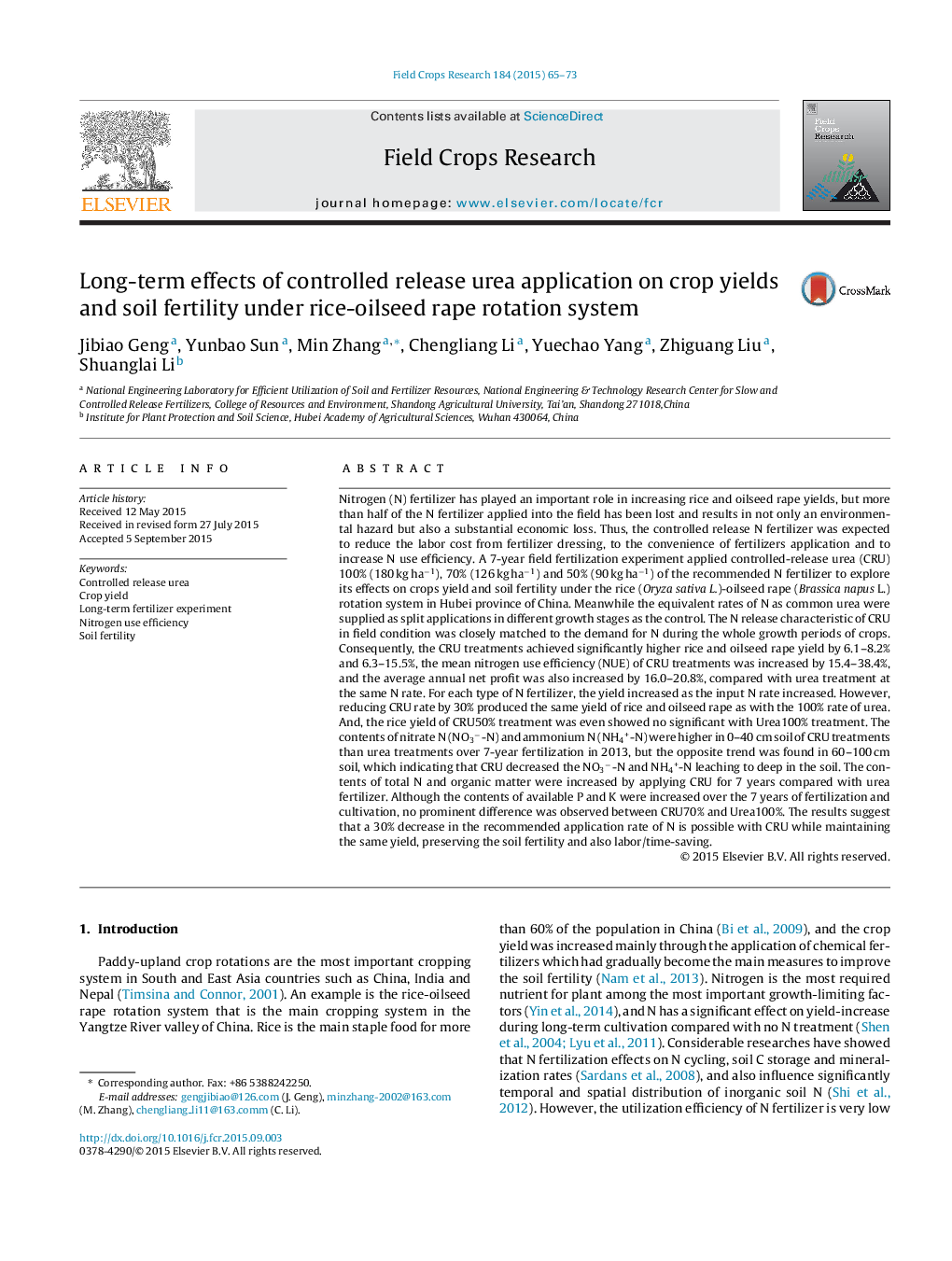| کد مقاله | کد نشریه | سال انتشار | مقاله انگلیسی | نسخه تمام متن |
|---|---|---|---|---|
| 6374636 | 1624679 | 2015 | 9 صفحه PDF | دانلود رایگان |
عنوان انگلیسی مقاله ISI
Long-term effects of controlled release urea application on crop yields and soil fertility under rice-oilseed rape rotation system
ترجمه فارسی عنوان
اثرات بلند مدت مصرف اوره آزگار کنترل شده بر عملکرد محصول و باروری خاک تحت سیستم چرخش عصاره برنج و روغن زیتون
دانلود مقاله + سفارش ترجمه
دانلود مقاله ISI انگلیسی
رایگان برای ایرانیان
کلمات کلیدی
کنترل اوره اوره بازده محصول، آزمایش طولانی مدت کود، استفاده از نیتروژن بهره وری، باروری خاک،
موضوعات مرتبط
علوم زیستی و بیوفناوری
علوم کشاورزی و بیولوژیک
علوم زراعت و اصلاح نباتات
چکیده انگلیسی
Nitrogen (N) fertilizer has played an important role in increasing rice and oilseed rape yields, but more than half of the N fertilizer applied into the field has been lost and results in not only an environmental hazard but also a substantial economic loss. Thus, the controlled release N fertilizer was expected to reduce the labor cost from fertilizer dressing, to the convenience of fertilizers application and to increase N use efficiency. A 7-year field fertilization experiment applied controlled-release urea (CRU) 100% (180 kg haâ1), 70% (126 kg haâ1) and 50% (90 kg haâ1) of the recommended N fertilizer to explore its effects on crops yield and soil fertility under the rice (Oryza sativa L.)-oilseed rape (Brassica napus L.) rotation system in Hubei province of China. Meanwhile the equivalent rates of N as common urea were supplied as split applications in different growth stages as the control. The N release characteristic of CRU in field condition was closely matched to the demand for N during the whole growth periods of crops. Consequently, the CRU treatments achieved significantly higher rice and oilseed rape yield by 6.1-8.2% and 6.3-15.5%, the mean nitrogen use efficiency (NUE) of CRU treatments was increased by 15.4-38.4%, and the average annual net profit was also increased by 16.0-20.8%, compared with urea treatment at the same N rate. For each type of N fertilizer, the yield increased as the input N rate increased. However, reducing CRU rate by 30% produced the same yield of rice and oilseed rape as with the 100% rate of urea. And, the rice yield of CRU50% treatment was even showed no significant with Urea100% treatment. The contents of nitrate N (NO3â-N) and ammonium N (NH4+-N) were higher in 0-40 cm soil of CRU treatments than urea treatments over 7-year fertilization in 2013, but the opposite trend was found in 60-100 cm soil, which indicating that CRU decreased the NO3â-N and NH4+-N leaching to deep in the soil. The contents of total N and organic matter were increased by applying CRU for 7 years compared with urea fertilizer. Although the contents of available P and K were increased over the 7 years of fertilization and cultivation, no prominent difference was observed between CRU70% and Urea100%. The results suggest that a 30% decrease in the recommended application rate of N is possible with CRU while maintaining the same yield, preserving the soil fertility and also labor/time-saving.
ناشر
Database: Elsevier - ScienceDirect (ساینس دایرکت)
Journal: Field Crops Research - Volume 184, December 2015, Pages 65-73
Journal: Field Crops Research - Volume 184, December 2015, Pages 65-73
نویسندگان
Jibiao Geng, Yunbao Sun, Min Zhang, Chengliang Li, Yuechao Yang, Zhiguang Liu, Shuanglai Li,
